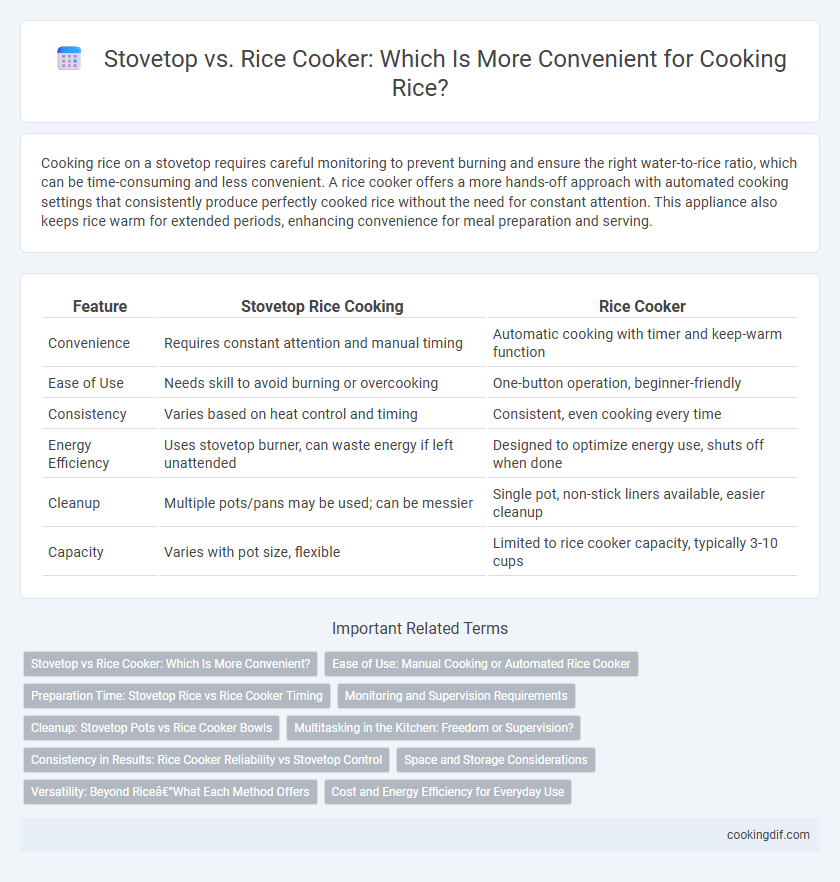Cooking rice on a stovetop requires careful monitoring to prevent burning and ensure the right water-to-rice ratio, which can be time-consuming and less convenient. A rice cooker offers a more hands-off approach with automated cooking settings that consistently produce perfectly cooked rice without the need for constant attention. This appliance also keeps rice warm for extended periods, enhancing convenience for meal preparation and serving.
Table of Comparison
| Feature | Stovetop Rice Cooking | Rice Cooker |
|---|---|---|
| Convenience | Requires constant attention and manual timing | Automatic cooking with timer and keep-warm function |
| Ease of Use | Needs skill to avoid burning or overcooking | One-button operation, beginner-friendly |
| Consistency | Varies based on heat control and timing | Consistent, even cooking every time |
| Energy Efficiency | Uses stovetop burner, can waste energy if left unattended | Designed to optimize energy use, shuts off when done |
| Cleanup | Multiple pots/pans may be used; can be messier | Single pot, non-stick liners available, easier cleanup |
| Capacity | Varies with pot size, flexible | Limited to rice cooker capacity, typically 3-10 cups |
Stovetop vs Rice Cooker: Which Is More Convenient?
Stovetop cooking requires constant attention and occasional stirring to prevent burning, making it less convenient for multitasking compared to a rice cooker. Rice cookers offer automated cooking with preset functions, allowing hands-free preparation and consistent results. The built-in timers and keep-warm features of rice cookers enhance convenience, especially for busy households.
Ease of Use: Manual Cooking or Automated Rice Cooker
Manual stovetop rice cooking requires continuous attention to water levels and heat adjustments, which can be time-consuming and prone to errors like burning or undercooking. Automated rice cookers use precise sensors and programmed cooking cycles to ensure consistent results with minimal user input, making them highly convenient for busy individuals. Rice cookers also often include features like timers and keep-warm functions, enhancing overall ease of use compared to manual stovetop methods.
Preparation Time: Stovetop Rice vs Rice Cooker Timing
Stovetop rice typically requires around 18 to 25 minutes of active cooking time, with additional attention needed to monitor boiling and simmering stages. Rice cookers streamline the process by automating cooking and warming functions, usually completing a batch of white rice in approximately 20 to 30 minutes without user intervention. This hands-off convenience reduces preparation time by eliminating the need for constant supervision, making rice cookers ideal for multitasking in busy kitchens.
Monitoring and Supervision Requirements
Rice cookers require minimal monitoring and supervision, automatically adjusting cooking time and temperature for consistent results. Stovetop cooking demands constant attention to prevent burning or boiling over, requiring regular stirring and heat adjustments. For hands-off convenience, rice cookers provide a more efficient and user-friendly solution.
Cleanup: Stovetop Pots vs Rice Cooker Bowls
Rice cooker bowls feature nonstick coatings that simplify cleanup by preventing rice from sticking, whereas stovetop pots often require soaking and scrubbing to remove stubborn rice residue. Rice cookers typically allow the bowl to be easily detached and washed separately, minimizing mess and effort. In contrast, stovetop pots can trap rice along the edges and bases, making post-cooking cleanup more time-consuming and labor-intensive.
Multitasking in the Kitchen: Freedom or Supervision?
Stovetop cooking requires constant supervision, limiting multitasking opportunities as you must monitor water levels and heat closely to prevent burning or boiling over. Rice cookers offer convenience by allowing hands-free cooking with programmable settings, enabling you to focus on other tasks without worry. This freedom enhances kitchen efficiency and reduces stress during meal preparation.
Consistency in Results: Rice Cooker Reliability vs Stovetop Control
Rice cookers offer consistent results by using automated temperature and timing controls, minimizing the risk of undercooked or overcooked rice. Stovetop methods provide greater manual control, which can lead to varying results depending on heat management and timing precision. For users prioritizing reliability and ease, rice cookers ensure uniform texture and doneness with less monitoring required.
Space and Storage Considerations
A rice cooker offers compact design and easy storage, ideal for small kitchens or limited counter space, whereas stovetop pots often require more storage room and may clutter kitchen cabinets. Rice cookers are typically lightweight and stackable, enabling efficient use of pantry space. Choosing a rice cooker maximizes convenience by combining cooking and warming functions in a single, space-saving appliance.
Versatility: Beyond Rice—What Each Method Offers
Stovetop cooking allows for greater versatility by supporting a variety of grains, soups, and one-pot meals, adapting easily to different recipes and cooking styles. Rice cookers offer specialized functions including steaming vegetables and cooking porridge, combining convenience with multi-functional use in a single appliance. Choosing between methods depends on kitchen needs, whether prioritizing manual control or automated versatility.
Cost and Energy Efficiency for Everyday Use
A stovetop rice cooker offers lower upfront costs compared to electric rice cookers, making it a budget-friendly option for everyday use. In terms of energy efficiency, electric rice cookers typically consume less electricity by maintaining optimal temperature and timing automatically. For households seeking convenience and minimal energy waste, electric rice cookers provide a cost-effective solution despite a higher initial investment.
Stovetop vs Rice cooker for convenience Infographic

 cookingdif.com
cookingdif.com